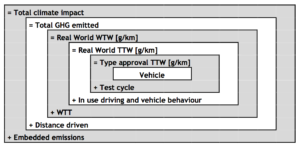An in-depth study on the design options of the post-2020 CO2 regulations for vehicles concludes that all targets asessed will have large net financial benefits for society and result in much lower costs for vehcile users. The study, Assessment of the Modalities for LDV CO2 Regulations beyond 2020 carried out for the European Commission by CE Delft, TNO and Cambridge Econometrics, also provided a broad range of recommendations for improving the design of the regulations.
The study shows net financial societal cost savings over the entire vehicle lifetime, both in 2025 and 2030. Both for cars and vans, the highest societal benefits were found with the most stringent target levels of 6% annual emission reduction between 2020 and 2030.
European Commission
On 8 November the European Commission presented their proposal for the post-2020 CO2 regulations for cars and vans. One of the inputs for this was an in-depth study on the design options of these regulations. In this study the pros and cons of design choices for the new regulations were assessed in detail on their well-to-wheel CO2 emissions, cost and the competitiveness of the EU automotive industry. All together 9,600 policy variants were assessed of which four in more detail on a broad range of impacts.
Ambition
The targets that were proposed by the European Commission are less ambitious: almost 4% per year. The study concludes that for meeting the 2030 objective for non-ETS sectors (Emission Trading Sectors), almost twice as high annual reduction rates of about 8% are likely to be necessary. Target levels that are fully robust for higher transport growth rates, low shares of biofuels, and only modest CO2 reduction rates in other transport modes, are (close to) 0 g/km in 2030, for both cars and vans.
Societal benefits
The societal benefits for the targets assessed were found to increase when the design of the regulations would be adapated, in particular when the utility parameter is changed from mass to footprint. Societal benefits in 2030 could amount over € 1,100 per car sold and even €3,500 per light commercial vehicle sold.
The societal benefits are the result of the energy cost savings exceeding the increase in manufacturing costs, up to € 1,700 per car and € 850 per van in 2030. These higher manufacturing costs translate in higher vehicle prices for end-users, but these are more than compensated by fuel cost savings. The net cost savings for car-users (accounted over the first five years and including taxes) are expected to be up to € 1,700 per car. The highest cost savings for end-users were found for the most stringent targets.
The higher manufacturing costs translate in higher vehicle prices for end-users, but these are more than compensated by fuel cost savings. The net cost savings for end-users (including taxes; accounted over the first five years) is € 400 to € 900 per car sold in 2025 and € 800 to € 1,700 per car sold in 2030. The lowest values were found for the current the design and the least stringent targets, while the highest values are for the alternative design and the most stringent targets.
Also for vans the higher manufacturing cost are more than compensated by energy cost savings over the entire vehicle lifetime, with overall even higher net cost savings for end-users.
Automotive sector
The study also concludes that the impacts on the competitive position of the EU automotive sector are expected to be very small and GDP is expected to increase in all variants assessed, up to 0.2%. The highest increase is found in the policy variants with the most stringent target level. In these cases, also employment, consumption and investments are expected to increase by at least 0.15%.
Source: CE Delft

